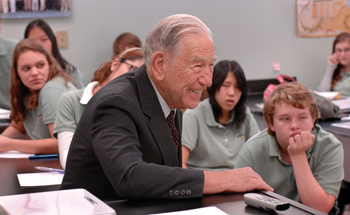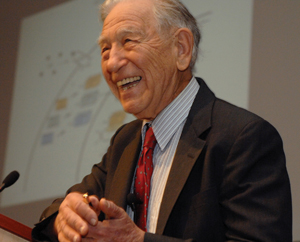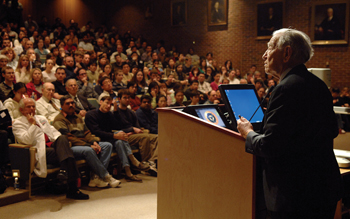
Nobel Laureate Stanley Cohen, Ph.D., talks with ninth graders from the School for Science and Math at Vanderbilt during his visit this week. (photo by Dana Johnson)
Cohen’s visit brings alive wonder, power of science

Stanley Cohen, Ph.D., was awarded the Nobel Prize in Medicine in 1986. (photo by Dana Johnson)

Light Hall was packed Tuesday as Cohen delivered the Ed Holloran Memorial Lecture, sponsored by the Alpha Omega Alpha Honor Medical Society. (photo by Dana Johnson)
The simple questions are often the most profound.
During a visit to Vanderbilt University Medical Center on Monday, Stanley Cohen, Ph.D., was pelted with inquiries from students as young as 9 years old about his pivotal work on nerve and epidermal growth factors, for which he earned a Nobel Prize in medicine in 1986.
How does adding nerve growth factor to a mouse embryo affect the function of its liver, heart and brain? Can a tumor be killed by changing its DNA?
“Very good questions,” Cohen answered. “We don't know the answers. It's up to you to figure it out.”
Speaking with youngsters is gratifying to this genial professor emeritus of Biochemistry, whose career path was decided, in large part, by his own early questions about how cells work and how the embryo develops.
That's why, in addition to giving the annual Ed Holloran Memorial Lecture and meeting with longtime colleagues and friends this week, Cohen took time out to chat with ninth graders from the School for Science and Math at Vanderbilt, and another group of students from central Arkansas who participate in an accelerated science program called the Aspirnaut Initiative.
His lecture, to more than 400 people who squeezed into 208 Light Hall on Tuesday, was the same message he gave to the younger students: he didn't set out to discover growth factors or their relationship to diseases like cancer when he began his research a half century ago.
“You can't hunt for something you don't know exists,” he told the students. “I was just curious … you've got this fertilized egg — one cell. Then the cell can turn into a frog or a chicken or a person. How does an egg turn into anybody? How does it work?”
Born in Brooklyn 85 years ago, this son of a tailor and a homemaker also was lucky. His grades were good enough in high school to get him admitted to Brooklyn College, where tuition was free.
After graduation, Cohen was working at a milk plant, checking the milk trucks for bacteria, when a teacher suggested he apply to the master's program at Oberlin College, which would cover his tuition and pay him $300 a semester. “That's how it started,” he said.
Cohen went on to the University of Michigan, where for his Ph.D. thesis in biochemistry, he studied how earthworms converted nitrogen into urea. “Every evening I took the hose and watered the lawn,” he said. “I put on a miner's cap and caught thousands of them.”
Knowing that passers-by would not believe he was working on his Ph.D., Cohen concocted various stories — that he was collecting worms to go fishing or that he was pledging for a fraternity. “They believed that,” he said.
Cohen's luck continued when he got a post-doctoral position with Viktor Hamburger, Ph.D., a pioneer in the study of nerve growth at Washington University in St. Louis.
Hamburger and Rita Levi-Montalcini, Ph.D., a visiting scientist from Italy with whom Cohen would later share the Nobel Prize, were trying to find out what made nerves in a chick embryo grow when a mouse tumor was implanted in it. They invited Cohen, the biochemist, to help.
Biochemists, Cohen told the students, “grind and find — they grind things up and make an extract.”
When Cohen put his tumor extract into the chick embryo, the nerves responded as well as they had to the tumor. Another Washington University faculty member and future Nobel Laureate, Arthur Kornberg, M.D., believed a virus must be responsible for spurring the nerve growth. He suggested that Cohen apply an extract of snake venom, which contains an enzyme that would inactivate any viral genetic material.
Cohen mixed the snake venom with his mouse tumor extract and applied it to the chick embryo. The next day, instead of no nerve growth, “there was a huge halo of nerve fibers.” What's more, the nerves grew just as well when only the snake venom extract was applied. Something in the venom was making them grow, Cohen said.
Recalling his biology, Cohen remembered that snake venom is produced in a modified salivary gland. So he tried ground-up salivary glands from mice. The nerves grew, not only in chick embryos but in baby mice.
Cohen also observed another remarkable thing. Baby mice open their eyes about 12 days after birth. But if enough salivary gland extract was given, they opened their eyes six days earlier.
Cohen recognized he had stumbled upon a fundamental discovery. While there are lots of ways that scientists can slow growth or stop it, “there are very few ways you can improve on nature and make it go faster.”
“Many new things are found by accident,” Cohen continued. “If you're prepared to see the accident, you can find it.”
With a young family to support, Cohen accepted a faculty position in the Department of Biochemistry at Vanderbilt in 1959. There, he continued to study eye-opening.
“Eyes open because the top layer of your skin dies and comes off,” he told the students “In humans it happens before you're born.”
Something in the extract was accelerating skin growth not only in mice, but in samples of human skin as well. “Therefore there must be something in the human like this,” he said. “How do you find it? You can't grind people up and make extracts.”
Cohen knew that various proteins and hormones are excreted in the urine. Eventually, he was able to isolate a protein from human urine that made the eyes of baby mice open earlier. It was named epidermal growth factor (EGF) because it made the epidermis — top layer of skin — grow.
The rest, as they say, is history. Identification of the protein led to the discovery of its receptor, to the link between a mutated EGF receptor and certain forms of cancer, and to the development of drugs like Herceptin and Gleevec, what Cohen called “ the first rational approach to how to slow down cancer.”
Now there are families of EGF-like proteins and of their receptors, being studied by thousands of scientists around the world. “That's when I decided to retire,” Cohen joked.
But though he left Vanderbilt in 1999 for retirement in Tucson, he has not stopped thinking about science or progress or the next generation.
“Do what you're interested in,” he urged the students. “If you're interested in it, you'll do well and then the rest will come.”













